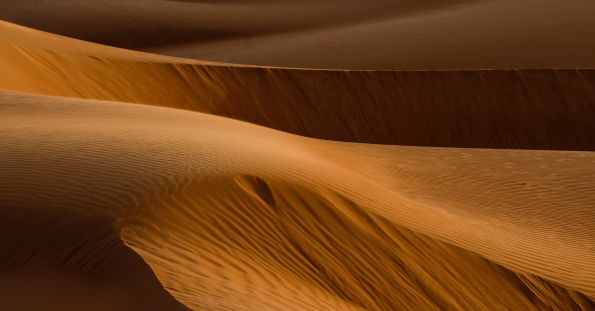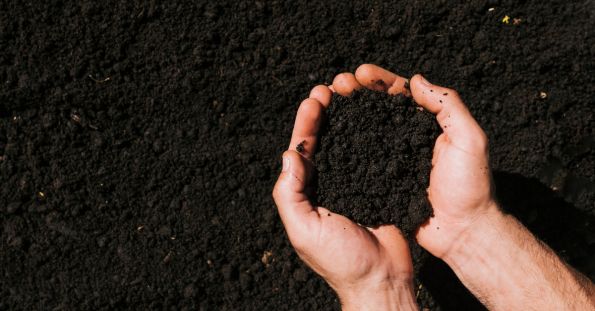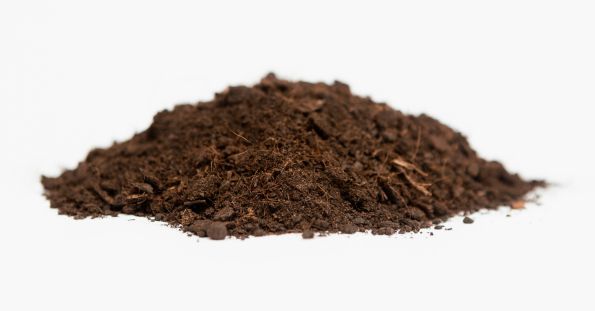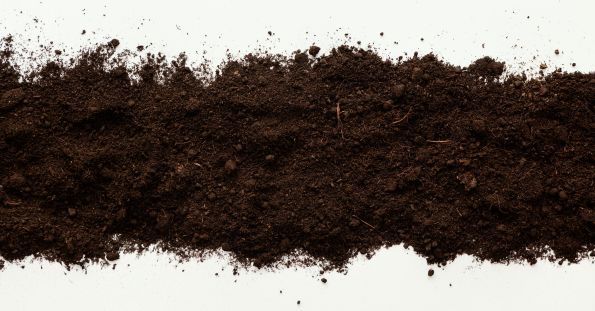Loading....
Close
Haven’t you wondered how the ground that we walk upon so freely changes in texture, color, and structure? The Earth’s surface is composed of different types of soils and each soil type has distinct characteristics that make it uniquely suitable for particular purposes.
In this article, you will get to know about how many various types of soil there are, there role and how they are formed. Let’s dive into the story of soil formation first and then, we will get acquainted with different soil types!
We generally refer to soil as the top layer that covers the majority of the Earth’s surface. Soil is a mixture of disintegrated rocks, humus, and many organic and inorganic substances. It is primarily produced from the weathering of rocks.
Many factors such as the impact of water, wind, temperature change, gravity, chemical interaction, living organisms, and pressure differences cause the rocks (the parent material of soil) to naturally erode. These then break down into smaller pieces and finer particles. These particles mix with the organic matter such as decomposed leaves and plant material to form soil as we see and experience it.
Soil develops slowly with its composition and structure evolving with time. The process of soil formation can take up to hundreds of years. That’s why it falls under the category of non-renewable resources.

Soil is the foundation of life on Earth. It is crucial for ecosystems to thrive as it is the layer in which plants of various kinds take root and get nutrition. In a way, it puts food on our table and helps the dependent fauna of the region to fully flourish. It is the water-filtering, nutrition-giving habitat of multitudes of organisms that are part of diverse ecosystems.
Different types of plant life prosper in different types of soils. That’s the reason when gardening or planting trees, one should especially consider the type of soil one uses so that the planted sapling is provided with ample nourishment and proper growth.
Additionally, soils are used for a number of purposes including construction, making clay utensils, pottery, and even more.
Also Read : How Can We Nurture Children’s Organic Growth?
Each soil type has different origins, thus, they display diverse characteristics. Primarily, the soil type in any region is affected by five factors – climate, organisms, topography, parent material, and time.
Climate – Temperature & precipitation received by an area leads to the formation of different types of soil as rains enrich the soil with specific minerals and salts and climate decides which fauna flourishes in the region.
Organisms – Microorganisms and animals inhabiting the area decompose the plant and animal tissue which becomes humus and changes the soil color and its characteristics.
Parent Material – The minerals and rocks that soil originates from influence the soil particle size, the minerals it contains, its pH levels, and the nutrients it holds.
Topography – Where the soil lies in the soil profile also affects its texture as soil near the river bed is continuously drawn away and thus, it is shallower than the soil found on the top of the hill.
Time – Since soil formation is a time-consuming process, you can find differences in the soil at different stages. You will find that younger soils are usually shallower and more fertile.
Let’s take a tour of the different types of soil that we come across while travelling through the cities and countries, supporting the growth of various flora and fauna.
There are six major types of soil on the basis of the size of granules, composition, structure, texture, and the proportion of different organic and inorganic matter they are composed of.

Sand is the type of soil that one can find in deserts. It is light in weight and warm & dry in feel. It is formed from small particles of weathered rocks. The sandy soil consists of the largest particles among the different soil types, formed from broken-down fragments of granite, limestone, and quartz.
Water quickly drains through the large particles of sandy soil which makes it the perfect soil type for the drainage system but poorly suited for growing vegetation.
You can spot sparse vegetation in the desert as it, for the most part, consists of sand which is low in nutrients and water-holding capacity.
Suitable Crops: The vegetation that grows in sandy soil includes Khejri, Lavender Plant, Potatoes, Hibiscus etc. Sandy soil is often known as light soil as it contains a high sand proportion with little clay (light soil as sand is much lighter than clay).
Also Read : Importance of Community Workers and Their Roles

Clay soil is the densest and heaviest soil type which contains higher amounts of nutrients and an excellent water-holding capacity. It has the smallest, tightly packed particles with very little space for air or moisture. This strengthens the water-holding capabilities of the clay soil.
Clay soil becomes hard & rocky and looks compact when dry and is sticky and bumpy when wet. If you observe water puddles formed on the ground rather than water being soaked in completely, it’s a sign of clay soil. You can also make certain if it’s clay soil or not by checking whether the soil sticks to shoes and garden tools and whether it forms solid soil crusts when dried.
Clay soil is rich in nutrients such as calcium, potassium, and magnesium but has a tendency to be heavier in winter and alkaline in ph.
Suitable Crops: It is suitable for plants like Brussels sprouts, Broccoli, Cabbage, Cauliflower, etc.

Silt soil has medium-sized particles which are smaller than that of sandy soil but larger than that of clay soil. Due to this, silt soil gets the best of both worlds and is well-drained with good moisture-holding capabilities and a high fertility rating.
Silt soil is easily washed away during rains and is transported from one place to another with the moving currents. It is the soil type you would find near water bodies such as rivers, lakes, and more which we know are the most fertile regions for cultivation due to the ample water supply nearby.
Thus, silt soil is very fertile and is used for the cultivation of crops. When you roll silt soil between your fingers, you will find that it leaves dirt behind on your hands.
Suitable Crops: Grasses, perennials, climbers, shrubs, and other plants thrive in silt soil. The crops this soil is suitable for include tomatoes, butterfly bushes, daffodils, peonies, etc.
Also Read : Unveiling The Inner Qualities of True Champions

Peat is known to be the surface layer of soil that contains an exceeding amount of organic matter. It is composed mainly of decomposed plants that have accumulated for long periods of time.
Peat soil has high humus content and greater water retention capability. It is usually introduced into a garden to offer a good base for saplings to be planted.
Peaty soil is black or dark brown in color due to the high organic matter present in it. It feels soft and spongy when touched and can be easily compressed for containing a good amount of water content.
When drained and composted properly, Peaty soil is used to cultivate good rice crops as it fulfills its high irrigation demand.
Suitable Crops: This soil type is also best suited for plants such as legumes, salad crops, root crops, and shrubs. Crops like onions, carrots, celery, sugar beet, lettuce, and market garden grow well on peat soil.
Chalky soil is formed from chalk or limestone and is alkaline (ph of 7.1 or higher) to a large extent due to calcium carbonate (lime) being present in it. Where chalky soil is found with good depth, it can retain moisture well and is not likely to dry out quickly in summer.
Also, when a good percentage of clay is present in the soil, it becomes capable of retaining good levels of organic material and nutrients.
Mostly, the plants that thrive in alkaline conditions do well in chalky soil while others when planted in chalky soil are most likely to die due to the adverse conditions.
You will also notice the texture of chalky soils contains chalk lumps and is white in color which makes it easier for one to distinguish.
Suitable Crops: Vegetables such as asparagus, cucumbers, squash, and flowering shrubs such as lavender, and hydrangea are grown in chalky (alkaline) soil.
Also Read : Does Spreading Knowledge Foster Growth?

Loam soil is a blend of sand, silt, and clay and has all the perks of the three soil types. It retains moisture and nutrients exceptionally well and offers a good drainage system which makes it best suited for crop cultivation. This soil is often called agricultural soil for this reason.
Loamy soil contains a good amount of humus, high calcium content, and pH levels due to its inorganic source. In loam soil, you will strike the right balance of the different particle sizes, apt for farming.
Dark in color and crumbling when dry and touched, it is the soil type that’s gardeners’ favorite to work with. It’s because the plants flourish in it with air and water moves easily to the roots between its particles.
Suitable Crops: Loamy soil is fine-textured and supports the growth of largely all types of fruits and vegetable crops. Bamboo, climbers, and shrubs, all thrive in loam soil. This soil is suitable for crops like cotton, sugarcane, wheat, oilseeds, and pulses, etc.
Saline soil is the type of soil with soluble salts in high amounts. The high concentration of salt prevents the absorption of water in the plants, causing difficulty in impeding germination. This type of soil has the presence of sodium, calcium, and magnesium. The soil has a sufficient amount of calcium and magnesium according to the needs of the crops.
However, the two components that are dominant ions are sodium and chloride. These ions are specifically very high in saline soil. It can be identified by the white layer on the surface of the soil and the poor growth of the plant.
Geographically, this type of soil is identified by areas like arid, semi-arid, humid, and sub-humid. These soils are majorly found in Barisal, Khulna, Patuakhali, Satkhira, Chittagong, Laxmipur, Noakhali, Gopalganj, Feni, Pirajpur, Jhalkati, Faridpur, Barguna, Bhola, Cox’s Bazar, Bagerhat, Magura, Jessore, Narail districts of the offshore and coastal lands.
Suitable Crops: The crops that grow on these kinds of soil include cotton, cabbage, beets, spinach, grain sorghum, Bermuda grass, tall wheatgrass, cereals, etc.
Also Read : Difficult Roads Often Lead To Beautiful Destinations
Now that you are well acquainted with the different types of soil, the next step is to find out which type of soil your garden or your surrounding area has. You can discover what kind of soil you are working with even without getting your hands dirty. All you have to do is fill the soil sample in a jar, shake it energetically, and let it settle overnight.
The next day, when you take a look, you will find that different soil layers will appear. The topsoil is clay with silt in the middle and sand at the bottom. The width of the layer will give you a fair idea about which dominant soil type you are planting in. Have fun planting and growing your saplings.
The different soil types and textures decide the ability of the soil to withstand water erosion and wind. Therefore, it decides the type of vegetation that will grow on a particular type of soil. Deposition and erosion of soil is the biological process that leads to different landforms. Understanding the right and suitable rates of soil erosion helps to understand the development of soil conversion.
Soil is the top layer of the earth’s surface, formed with the mixing of weathered rocks with humus. Based on its composition and texture, soil can be classified into six types – sandy, clay, silt, peat, chalk, and loam soil.
Loam Soil is often called the gardeners’ best friend as it is the soil type best suited for the plant vegetation to thrive. It is formed with a mixture of clay, sand, and silt soil. It comprises organic matter and is comparatively very fertile than other soil types.

